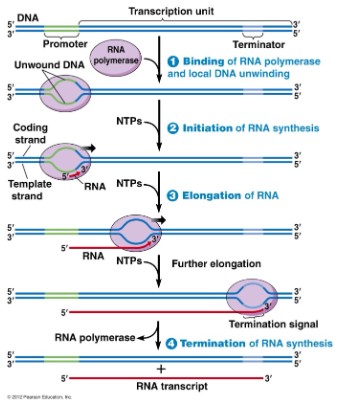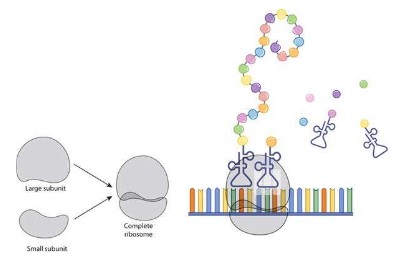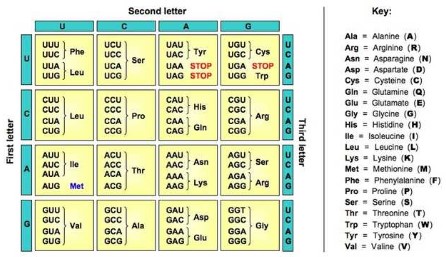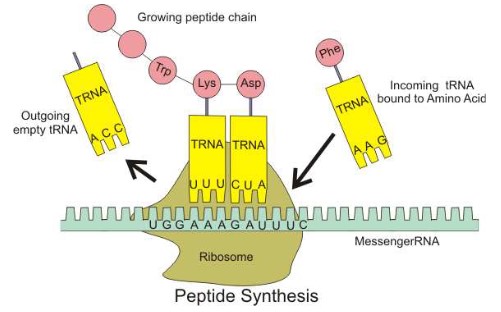Topic : 2 Molecular Biology
2.7 DNA replication, transcription, and translation
Replication of DNA
- Complementary base pairing ensures two identical DNA strands are formed after replication is complete.
- In replication, the original strands are used as templates, allowing complementary bases to be added according to base pairing rules.
- DNA replication is semi-conservative, meaning the new DNA that is created consists of one old strand (template) and one new strand
(synthesized strand). - The significance of complimentary base pairing means that the two daughter cells have the exact same DNA genome as the parent cell.
- Gene sequences (if no mutations occur) are therefore successfully passed on from generation to generation.
- Adenine is always matched with thymine with two hydrogen bonds and guanine is always matched with cytosine with three hydrogen bonds
Helicase unwinds the double helix and separates the two strands by breaking hydrogen bonds
- Unwind DNA helix
- Separate two strands by breaking the hydrogen bonds between base pairs
- ATP is require for helicase move along the DNA molecule and for breaking H bonds
- Two separate strands become template / parent strands for replication
DNA polymerase links nucleotides together to form a new strand, using the pre-existing strand as a template
- Free nucleotides found in the nucleus are added to the strands of DNA by an enzyme called DNA polymerase.
- DNA polymerase brings the nucleotide into position so a hydrogen bond can form between the base pairs
- A covalent bond is formed between the phosphate on the free nucleotide and the sugar on the existing chain
- Nucleotides are added to complimentary bases on the DNA template strands according base-pairing rules (adenine pairs with thymine and
guanine pairs with cytosine). - Bases are added in one direction on one strand and are added in the opposite direction on the other strand.
- Very few mistakes occur
- The newly formed DNA strands rewind to form a double-helix spiral staircase shape once again.
- DNA polymerase is an enzyme. This protein family consists of multiple polypeptides sub-units. The polymerisation reaction is a condensation reaction.
- DNA polymerase always moves in a 5’ to 3’ direction. DNA polymerase moves in opposite directions on each strands.
- DNA polymerases catalyse the covalent bonds between sugar and phosphate groups.
- Free nucleotides are collected by DNA polymerase and attached to the new strand by complementary base pairing
Use of Taq DNA polymerase to produce multiple copies of DNA rapidly by the polymerase chain reaction (PCR).
PCR is a way of producing large quantities of a specific target sequence of DNA. It is useful when only a small amount of DNA is available for
testing. E.g. crime scene samples of blood, semen, tissue, hair,etc.
- PCR needs a thermal cycler, primer (where DNA polymerase binds to), free nucleotides and DNA polymerase (Taq polymerase in this case)
PCR occurs in a thermal cycler and involves a repeat procedure of 3 steps:
- Denaturation: DNA sample is heated to separate it into tow strands.
- Annealing: DNA primers attach to opposite ends of the target sequence.
- Elongation: A heat-tolerant DNA polymerase (Taq) copies the strands.
- One PCR cycle yields two strand of new DNA
Tanscription

- In the nucleus, the cell’s machinery copies the gene sequence into messenger RNA, a molecule that is similar to DNA. Like DNA, mRNA has four nucleotide bases- but in mRNA, the base U replaces T.
- Transcription begins when the area of DNA that contains the gene is unwound by RNA polymerase
- RNA nucleotides found in the nucleus are added to the template strand of the DNA by the enzyme RNA polymerase according to base-pairing rules.
- RNA polymerase also creates covalent bonds between the nucleotides of the mRNA strand.
- Once the RNA sequence has been synthesised:
-RNA polymerase will detach from the DNA molecule
-RNA detaches from the DNA
– the double helix reforms - Transcription occurs in the nucleus (where the DNA is) and, once made, the mRNA moves to the cytoplasm (where translation can occur)

Three main types of RNA are predominantly synthesised:
- Messenger RNA (mRNA): A transcript copy of a gene used to encode a polypeptide
- Transfer RNA (tRNA): A clover leaf shaped sequence that carries an amino acid
- Ribosomal RNA (rRNA): A primary component of ribosomes
Translation is the synthesis of polypeptides on ribosomes.

- Translation is the synthesis of polypeptides with a specific amino acid sequence that is determined by the base sequence on the mRNA molecule
- That base sequence is determined by the specific gene
- Translation takes place at the ribosomes in the cytoplasm or on the rough ER
- A ribosome is composed of two halves, a large and a small subunit. During translation, ribosomal subunits assemble together like a sandwich on the strand of mRNA:
- Each subunit is composed of RNA molecules and proteins
- The small subunit binds to the mRNA
- The large subunit has binding sites for tRNAs and also catalyzes peptide bonds between amino acids

The amino acid sequence of polypeptides is determined by mRNA according to the genetic code.
- The length of mRNA molecules varies
- Only certain genes in a genome need to be expressed
- Therefore not all genes (are transcribed) and translated
- If a cell needs to produce a lot of a certain protein then many copies of the required mRNA are created
Codons of three bases on mRNA correspond to one amino acid in a polypeptide.
- Codons are a triplet of bases which encodes a particular amino acid
- The codons can translate for 20 amino acids
- The order of the codons determines the amino acid sequence for a protein
- The coding region always starts with a START codon (AUG) therefore the first amino acid in all polypeptides is Methionine
- The coding region of mRNA terminates with a STOP codon ( UAA, UAG, and UGA) – the STOP codon does not add an amino acid – instead it causes the release of the polypeptide
- Amino acids are carried by transfer RNA (tRNA)
- The anti-codons on tRNA are complementary to the codons on mRNA

Translation depends on complementary base pairing between codons on mRNA and anticodons on tRNA
- Process where amino acids are combined to form proteins (polypeptides).
- mRNA has a sequence of codons (3 base pairs) that specifies the AA sequence of the polypeptide
- tRNA have an anticodon that matches and binds to their complementary codon carrying the AA corresponding to that codon
- After transcription occurs the transcribed mRNA moves out from the nucleus through the nuclear pore into the cytoplasm and binds to the ribosome unit either in the cytoplasm or attached to the rough ER
- mRNA binds to the small subunit of the ribosome with its first two codons contained within the binding sites of the ribosome.
- The first codon is called the start codon (AUG) which codes for methionine.
- The corresponding tRNA attaches to the mRNA bringing the amino acid methionine to the ribosome to start the polypeptide chain.
- While still attached, a second tRNA attaches to the mRNA at the second binding site on the ribosome, carrying the amino acid that corresponds to the mRNA codon.
- The two amino acids are combined by a condensation reaction, forming a covalent dipeptide bond.
- The bond between the first amino acid and the tRNA that carried it to the ribosome is broken by an enzyme.
- The ribosome slides along the mRNA, moving down one codon releasing the tRNA back into the cytoplasm so it can go pick up another amino acid (in this case methionine).
- Another tRNA moves into the empty site bringing the next amino acid that corresponds to the mRNA codon.
- Again, the amino acid is attached to the polypeptide and the previous tRNA is released back into the cytoplasm as the ribosome moves along the mRNA.
- This process continues until 1 of the 3 stop codons (UAA, UGA, and UAG) is reached. These tRNA have no attached amino acid.
- Finally, when the ribosome moves along the mRNA, the polypeptide will fall off and be released into the cytoplasm

Production of human insulin in bacteria as an example of the universality of the genetic code allowing gene transfer between species.
- All living things use the same bases and the same genetic code.
- Each codon produces the same amino acid in transcription and translation, regardless of the species.
- So the sequence of amino acids in a polypeptide remains unchanged.
- Therefore, we can take genes from one species and insert them into the genome of another species.
- An example of this is human insulin production.
